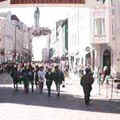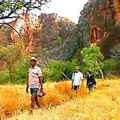|
By Jackie Alan Giuliano, Ph.D.
New Millennium
Old Millennium,Time is timeless.
Grasping is futile
Rejecting is painful,
Care lightly and gently.
Like a mother holding a child.,
Not too loose, not too tight.
-- Martine Bachelor, Zen Buddhist teacher, Sharpham College, England
The United Nations has declared the year 2002 as the International Year of Ecotourism. The goals of this designation are lofty and the UN hopes to make environmental protection an integral part of tourism development. But the idea that tourism can be sustainable at all may be a myth. It may not be possible for struggling nations around the world to resist compromising their environment and their culture to lure affluent foreigners and their dollars.

The old town, Tallinn, Estonia
Many different organizations, governments, and businesses have defined ecotourism, but I especially like the definition adopted by the Estonian Ecotourism Association. Estonia is the northernmost of the three Baltic countries, bordered by the Gulf of Finland in the north, Russia in the east, and Latvia in the south. This definition says, "Ecotourism is responsible travel, that conserves the natural and cultural heritage and contributes to the well-being of local communities."
The International Ecotourism Society defines ecotourism as, "responsible travel to natural areas that conserves the environment and sustains the well being of local people."
Some of the philosophies of ecotourism as outlined by the Estonian association include understanding the social carrying capacity of the area, understanding the ecological carrying capacity of the area, benefiting the local people, appropriate pricing strategies, building environmental costs into the prices of goods and services, and responsible marketing of tourist opportunities.
Has experience shown that these goals are even remotely possible?
The Rethinking Tourism Project states, "The environmental, cultural, social and economic impacts of tourism development reverberate in communities around the world, but increasingly target Indigenous Peoples. The last pristine wilderness areas: national parks, biospheres and other protected areas, coastal areas, mountains, jungles and deserts are all Indigenous homelands. All are being targeted for increased tourism development, often without full participation, management and ownership of Indigenous Peoples."

Indigenous man of Papua New Guinea (Photo courtesy government of Papua New Guinea)
Developments to attract tourists often conflict with traditional uses, such as subsistence farming, fishing or hunting. Sites that are sacred to the indigenous people of a region such as rivers, rocks, and other places of spiritual significance are being destroyed or invaded by tourists. When cultures and lands are changed or destroyed, they rarely revert back to their original uses or forms.
The tourist industry netted nearly $500 billion in 1999, but to whom did the money go? Certainly not to local craftspeople and merchants, who sell their wares, often hand crafted over many weeks, for a fraction of what their time would be worth in a tourist's home country. Certainly not to the thousands of native guides who have given up farming for their families to take a few paltry dollars from stingy tourists.
How often have you heard a friend or relative brag about how he got a beautiful piece of art for a couple of dollars? If a tourist was really interested in supporting the local culture, if the artisan asked for two dollars, the visitor would give $20 instead.
Lee Pera and Deborah McLaren, authors of the book "Rethinking Tourism and Ecotravel: The Paving of Paradise and What You Can Do to Stop It," report that "the tourism industry is encroaching on remote and biologically diverse areas, home to Indigenous Peoples, and threatens our environment and way of life."
The World Tourism Organization said that in 1998 there were 635 million tourist arrivals around the world. Pera and McLaren said that few of these tourists leave any benefit behind for poor, Indigenous Peoples.
In an article for their Rethinking Tourism website, Pera and McLaren wrote, "For the recipients [host countries] of international tourism, the tourism industry creates dependency upon a fickle and fluctuating global economy beyond their local control. Local economic activities and resources are used less for the benefit and development of communities and increasingly for export and the enjoyment of
others."
"With so few international policies and guidelines restricting it," Pera and McLaren say, "tourism has been given free reign to develop throughout the world. In fact, it has led the globalization process in the areas of transportation, communications, and financial systems."

Dillon Andrews, a traditional Bunuba man, leads a tour to some of the oldest rocks on Earth in Western Australia. (Photo courtesy Aboriginal Australia)
http://ens-news.com/ens/sep2001/2001L
-09-07g.html
|
